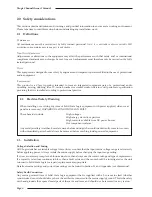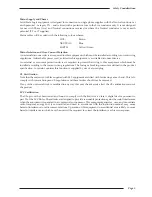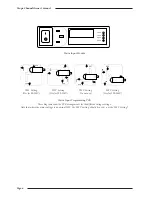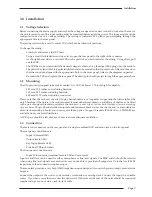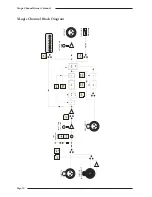
Channel Equaliser
Each channel contains a four band equaliser that can be switched between two different sets of curves, one based
on SSL’s G Series EQ and the other based on the latest version of the classic E Series EQ. High and low pass filters
are also available.
The LF and HF bands have variable turnover frequency with switchable bell/shelving and selectable response
curves (see the upper plot, opposite):
• Normal (‘G type’) curves with the ‘E’ switch OUT, have a modified slope with a degree of
overshoot/undershoot for increased selectivity
• ‘E type’ curves with the ‘E’ switch IN follow conventional cut or boost characteristics
The two parametric bands have selectable characteristics which affect the relationship between frequency
bandwidth and gain (see the lower plot, opposite):
• With the ‘E’ switch OUT, the frequency bandwidth reduces with increased gain, thereby increasing the
selectivity of the EQ as the gain is increased
• With the ‘E’ switch IN, the frequency bandwidth is constant at all gains
• At full boost or cut both are identical
HF Band controls:
Frequency
Variable from 1.5kHz to 22kHz
Gain
Variable between ±20dB
‘Q’
2.5 (on ‘BELL’ setting)
HMF Band controls:
Frequency
Variable from 600Hz to 7kHz
Gain
Variable by > ±20dB
‘Q’
Variable from 0.5 to 2.5 (may also vary with gain)
LMF Band controls:
Frequency
Variable from 200Hz to 2.5kHz
Gain
Variable by > ±20dB
‘Q’
Variable from 0.5 to 2.5 (may also vary with gain)
LF Band controls:
Frequency
Variable from 40Hz to 600Hz
Gain
Variable between ±16.5dB
‘Q’
2.5 (on ‘BELL’ setting)
Filter controls:
Low Pass
3kHz to 50kHz (–3dB Point) @ 12dB/Octave
High Pass
20Hz to 500Hz (–3dB Point) @ 18dB/Octave
Measurement Conditions
Signal applied to Input A and measured at Output. EQ switched In. All EQ controls set centre as appropriate.
THD + N
< 0.005% at +20dBu 1kHz
< 0.007% at +20dBu 10kHz
Frequency Response
±0.1dB from 20Hz to 20kHz
–3dB at 200kHz
Output Headroom
> +26dBu at onset of clipping
Noise
< –86dBu
XLogic Channel Owner’s Manual
Page 18
Summary of Contents for XLogic Super Analogue
Page 1: ...Super Analogue Channel Owner s Manual ...
Page 2: ......
Page 29: ...Notes Appendix Page 25 ...

